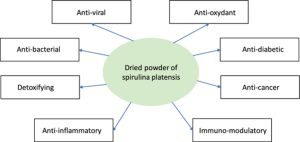
Published in: Journal of Young Pharmacists, 2023; 15(3): 441-447. Published online: 22 August 2023DOI: 10.5530/jyp.2023.15.59
ABSTRACT
Spirulina, a tiny blue-green algae, is a great dietary supplement for both people and animals since it is among the planet’s finest sources of organic nutrients. In addition to being a rich source of high-quality proteins, vitamins, and minerals, spirulina also contains a wide range of naturally occurring carotene and xanthophyll phytopigments. Due to its extraordinary and astounding nutrient content, which not only enhances their nutritional properties but also serves medical reasons, spirulina is used as a dietary inclusion in a wide range of food products. Spirulina has a variety of pharmacological properties, including antimicrobial (including antiviral and antibacterial), anticancer, antimicrobial, anti-inflammatory, hypocholesterolemic, radio protective, and metalloprotective (prevention of heavy-metal poisoning against Cd, Pb, Fe, and Hg). This is because of its high protein, polysaccharide, lipid, essential amino and fatty acid, dietary mineral, and vitamin content. Phycocyanin, carotene, tocopherols, linolenic acid, and phenolic compounds are some of the natural components of spirulina that have been shown to have potent antioxidant properties and strong scavenging activities against Reactive Oxygen Species (ROS), such as superoxide and hydrogen peroxide radicals. These substances are responsible for spirulina’s therapeutic and pharmaceutical properties. An overview of the therapeutic uses for Spirulina spp. is provided in this article.
Keywords: Spirulina, Micro-algae, Pharmacological activities, Reactive Oxygen Species (ROS)
